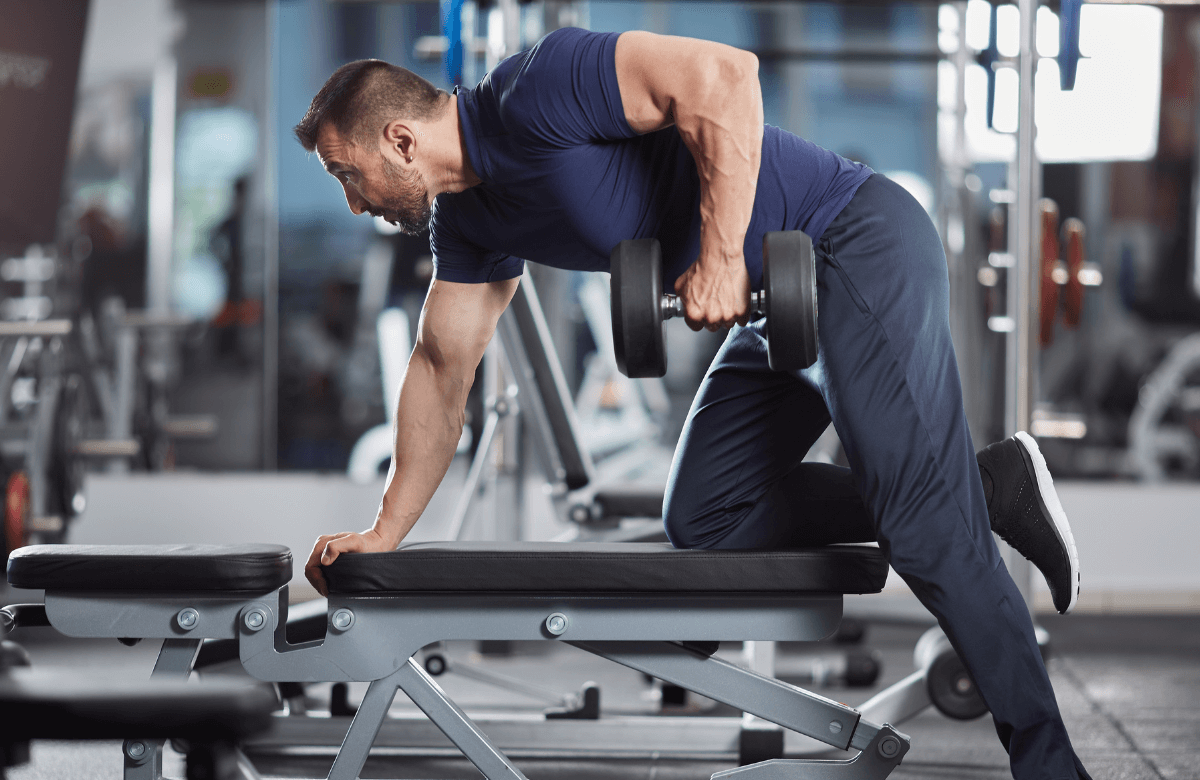If you want a sculpted back or to widen your back to really get that V-shape, you’ve got to work your lats. Muscular lats add width and shape to your back, so they’re essential for aesthetics.
But working on your lats is also important for strength and stability. The stronger your lats, the less likely you are to injure your shoulders, back, and arms during heavy lifting. The lats also play a huge role in core stability.
If you aren’t a fan of the traditional lat pull-down or you workout from home and don’t have machines, dumbbell lat exercises are easy to add to your routine.
Don’t assume they won’t be enough to work your back hard. You can build a tough, muscular back with just a set of dumbbells as long as you choose the right exercises and lift the right amount of weight.
Jump to:
How To Get Bigger Lats With Only Dumbbells
Yes, lat pulldowns, rows, and barbell deadlifts work those lats. But don’t discount the power of lat exercises with dumbbells… Do them right, and you can really target the lats and help them grow.
One of the reasons adding dumbbells to your lat routine is a great idea is that they’re horizontal pulling movements, rather than vertical movements, like pulldowns and pull-ups. You can do horizontal movements with the barbell, but the range of motion is less.
Can Dumbbell Lat Exercises Make Your Lats More Visible?
Any lat exercises that build muscle will make your lats more visible. It doesn’t matter if you use a barbell or a dumbbell, if you’re lifting heavy with proper form and hitting the right muscle, they’ll grow.
Note that it won’t happen overnight—but neither will getting big lats with barbell exercises. Consistency is key, but if you’ve only got dumbbells at your disposal, you can definitely build a great set of lat muscles.
Muscles Worked by Dumbbell Lat Exercises
Obviously, your lats are the muscles that are most targeted by these exercises. The lats (or latissimus dorsi) are the largest muscles in the back. They’re located just behind your ribs on either wide, underneath your arms.
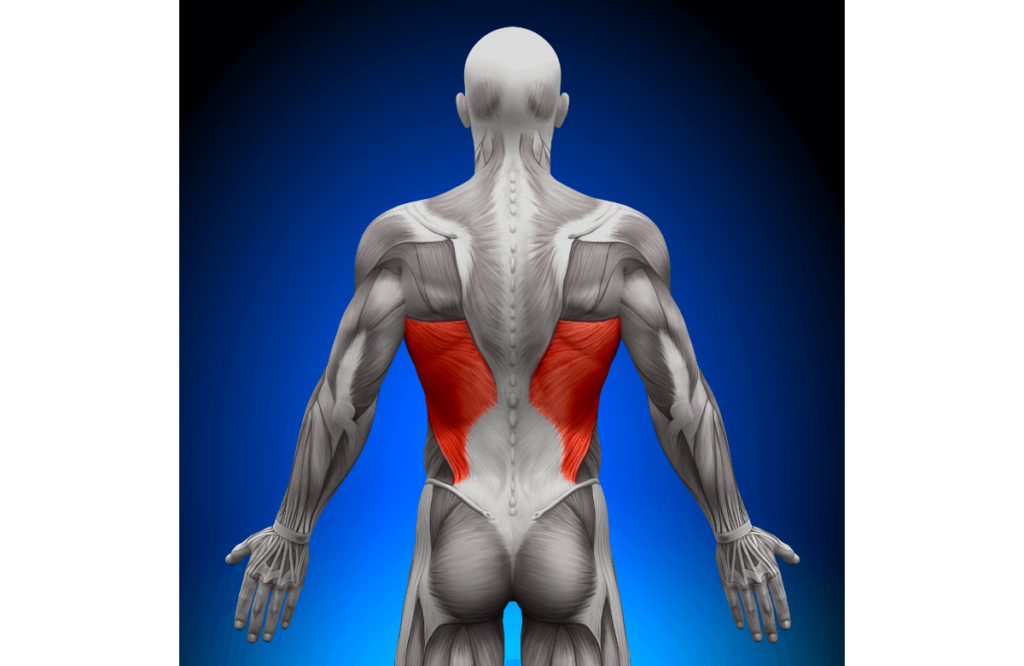
But they’re not the only muscles that dumbbell lat exercises hit. Other muscles will get a little activation as well, as they’re intrinsically connected to the lats. Smaller muscles in the upper back like the rhomboids, rear delts, and the lower trapezius also get some action during these movements.
Benefits of Using Dumbbells for Lat Exercises
While it’s often a natural inclination to grab a barbell or head to the cable machine for pulldowns, opting for dumbbells has some benefits over those two. Here’s why you should opt for dumbbell lat exercises instead.
Easy Muscle Targeting
Because you’re working one side at a time, it’s easier to really focus in on that muscle. Dumbbells are a great way to train your mind/muscle connection, because you can stabilize yourself on the side you’re not using.
This takes away some of the core activation, but it means you can really target that lat muscle directly. You’ll also feel it more easily, so you won’t accidentally be hitting another muscle more during the movement.
Can Work Each Side Independently
No need to worry about unbalanced lats. With dumbbells, you can work each side independently, so if you need to work one side a little harder to get it up to speed, it’s easy.
On the flip side, be careful here. It’s also easy to accidentally work yourself into a muscle imbalance if you hit your dominant side harder than the other side.
Greater Range of Motion
Your range of motion is restricted with a barbell. Once the barbell hits your torso, there’s no way to move it anymore. On a pull-up bar, you’re working against gravity, which means there’s only so far you can go.
But with dumbbells, you’ve got a lot more freedom. They’re smaller and easier to move, so when doing a dumbbell row, for example, you can really pull that elbow back a lot further than you’d be able to with a barbell.
Typically, a bigger range of motion means more muscle activation. But, it also means being able to move in a way that’s less restrictive on the joints, which is excellent news for those who struggle with joint immobility on barbell exercises.
Versatile & Convenient
One of the best things about dumbbells over barbells is that you can change up your grip. The simple change from a pronated grip to a neutral grip can target the muscle differently, so it’s an excellent way to beef up your back workout.
Dumbbells are a lot more versatile than barbells or cable machines. Between the increased range of motion and the varied grip options, you have an almost endless array of movements to target whatever muscle you’re aiming for.
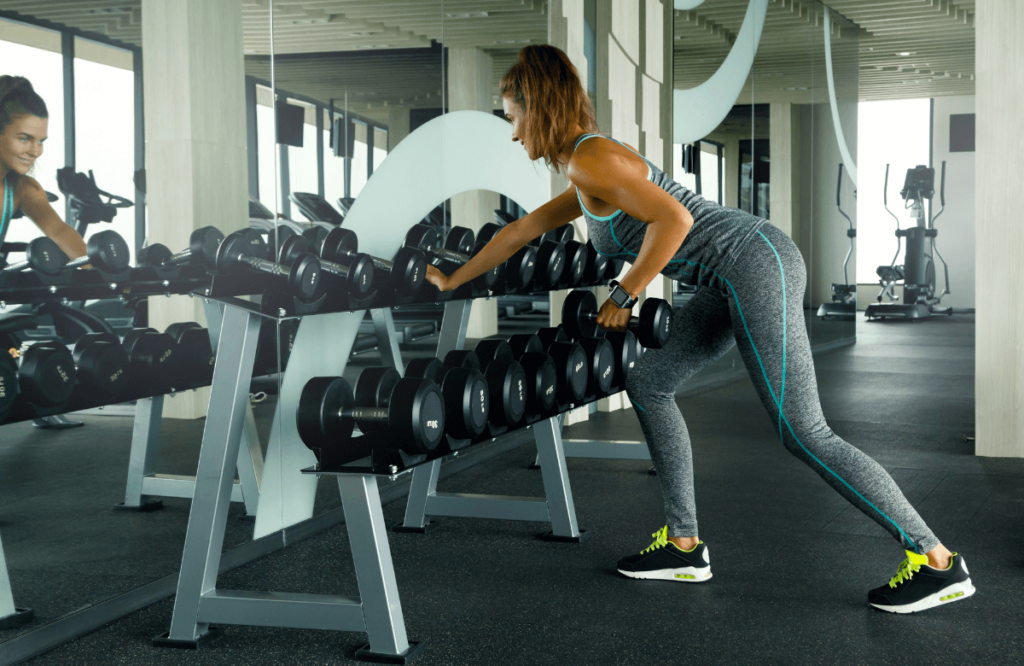
How Often Should You Train Lats?
The lats are big muscles, so they need ample time to recover after you work them hard. Some schools of thought will tell you to train lats once a week and give them a week to recover before hitting them again.
Others, though, suggest that training the muscle group twice a week is optimal for hypertrophy. This is also ideal if you want to split your workout into upper and lower lats.
Ultimately, it’s up to you what you choose. Training lats once a week isn’t a bad thing, but they won’t grow as quickly as if you train them twice a week. But for some, training them twice a week might feel like you’re overdoing it or neglecting other muscle groups. Consider your current training program and what might be best for you based on that.
How Long Does It Take to Build Lats?
This is quite subjective. If you’re training them hard twice a week, you should see results in as little as 6 weeks. If you’re doing lats once a week, you can expect 10 to 12 weeks before you really notice size and strength gains.
That being said, it also depends on the quality of your exercises. If you’re doing your lat workout with poor form, you won’t see great results. On the other hand, if your form is perfect but you’re lifting too light and not pushing your muscles at all, you still won’t gain.
Experience and current physique also play a role. If you’ve been lifting forever and have pretty decent lats already but you’re trying to add more size, it might be harder to notice a significant difference on top of already-built lats.
On the other hand, if you’re a newbie and you’re lifting with great form, you’ll most likely see those “newbie gains”, which often happen in much less time than normal.
The key is to stay consistent over at least 3 months. If you’ve seen no gains at that point, drop the weight and focus on form and range of motion. Small errors in these two aspects could be hampering your gains!
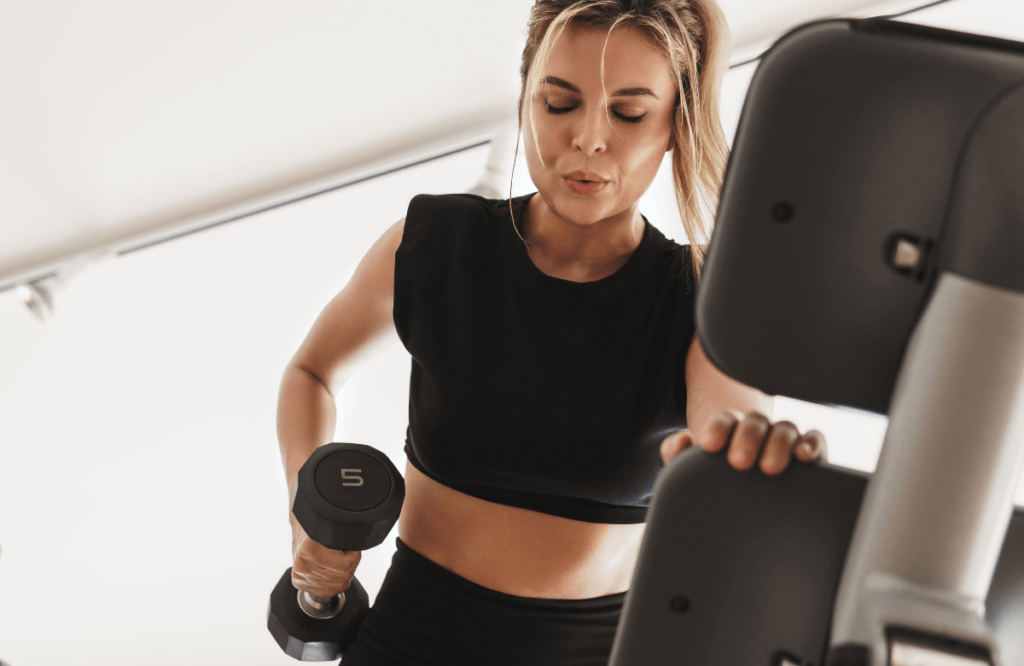
The Best Lat Exercises With Dumbbells
These are the top dumbbell exercises to target your lats. Many of them are simply row variations, but including all of them or a combination really hits the lats nicely.
Pick the ones that work best for you, although it’s a good idea to switch them up here and there to prevent boredom and work your muscles a little differently.
Like all exercises, you should be aiming to do 3 to 4 sets of 4 to 6 reps (men) or 8 to 10 reps (ladies). Don’t forget every rep should be done with excellent form until you hit that upper number, and then you can increase the weight.
Dumbbell Bent-Over Row
The bent-over row is a back workout staple. You can do it just as easily with a pair of dumbbells as with a barbell, and for this variation, we’ll do both hands at once.
Begin by standing with your feet hip-width apart, dumbbells in hands. Bend over at the waist, keeping a slight bend in your legs for stability. Keep your back as straight as possible, and keep your head facing downwards. You should be looking at the ground.
Your arms should be extended, loose at the shoulders, with the dumbbells hanging. Tighten your core and tense your lats, bringing your elbows up as close as possible to your sides as you lift the dumbbells.
You should feel the full stretch in the lats as your elbows move past your torso. Hold it here for a moment and feel the squeeze. Then, release it slowly back down, paying attention to how the muscle lengthens.
To target the lower lats more specifically, we recommend doing the dumbbell row to the hips instead of higher. Instead of pulling up to the rib area, the dumbbells should be lifted until your hand is next to your hip, closer to your thigh than to your chest.
It’s not easy to do, especially if you’re used to the regular way of doing dumbbell rows. With focus and practice, you’ll be able to feel the activation in the lower lat rather than the upper. You might find that this is easier to do with a barbell, because you can use an underhand grip.
Single-Arm Dumbbell Row
We like the single-arm dumbbell row as it’s a unilateral movement that really helps you to target those lats one at a time. You’ll need a flat gym bench for this one, or a table or flat surface you can use for support if you’re working out at home.
Place a knee on the bench. Hinge at the hips and place the same-side hand on the bench as well. Your free hand should be holding your dumbbell, loose and hanging. Don’t tense the shoulder!
The first step of the single-arm row is to engage the lat muscle. Basically, this means to set your shoulder joint back in its socket (without lifting your back), and tighten the lat so it moves slightly backwards, towards the hip.
From here, lift the dumbbell by bringing your elbow back and up. You’ll feel the contraction in the lat muscle. Make sure you move through the full range of motion, hold for a second at the top, and bring it back down slowly.
Do your reps on one side and then turn around and do the same on the other side. Make sure you release the movement fully at the bottom, by releasing that shoulder joint before setting it back again to do the next rep.
Pay attention to keeping your back straight and not arching it. Also, avoid swinging the weight up and using momentum to lift.
Dumbbell Pullover
The pullover exercise is an excellent compound movement that works both the lats and the chest. It was one of Arnie’s favorites, so you can imagine how effective it is!
You can start either lying flat on your back on a bench. But we recommend doing it with your shoulders on the bench and your body perpendicular to the bench. Your feet should be hip-width apart, your hips raised in a bridge position, and your abs and glutes should be tightened.
You should hold the dumbbell with a diamond grip, with the head of the dumbbell resting in your palms. Extend your arms so the dumbbell is above your face—be extra careful here, because the potential for injury is definitely there.
Keeping your arms extended and with a slight bend in your elbows, lower them slowly behind your head. Let the dumbbell hang—don’t try and hold it tightly.
Aim for your arms to be parallel to the floor. Make sure your back doesn’t arch during the movement. Once you feel the stretch, hold it for a second, and then gently bring the dumbbell back up by contracting your lats.
The lowering movement gives the lats a great stretch, but it’s the raising motion that really works the muscle. Inhale as you lower the weight, and exhale as you bring it back up again.
Make sure not to drop your butt during the movement. Your body should remain as straight as possible from knees to neck. If you find that your neck hurts when your shoulders are on the bench, you might want to lie on the bench the right way so your head is supported.
Incline Rows
For the incline dumbbell row (also called chest-supported rows), you’ll be lying on an incline bench at a 45-degree angle on your stomach (prone). Once you’re resting with your chest on the bench, you’re going to do a dumbbell row like you normally would, only you’ll be nicely supported by the bench.
Remember to keep your elbows close to your sides, move through the full range of motion, set your shoulder back before lifting and loosen it at the bottom, and lift higher for upper lat engagement and closer to the hips for lower lat engagement.
Renegade Row
This is a super lat builder, but also amazing for building core strength. Start in a push-up plank position. You’ll be gripping your two dumbbells with your hands directly below your shoulders, back straight, abs tight, on your toes with your feet shoulder-width apart or even wider.
Engaging one of your lats, drive your elbow back and lift the weight to your side. Do it slowly and make sure not to twist your body or turn your hips or torso. Keep a tight core. Bring it back to the ground slowly, and then do the other side.
Note that this is a core and quad killer! You’ll need to really recruit those stabilizer muscles to keep your form here, so you might want to choose lighter weight to start with.
Dumbbell Deadlift
The barbell deadlift catches the lats as well as the other back muscles. The biggest mistakes made with dumbbell deadlifts is holding the dumbbells in the wrong position to target the lats, and bending the knees too much.
If you want to deadlift with dumbbells, make sure to mimic the barbell deadlift as closely as possible. In other words, keep the dumbbells in front of your legs, in the same position the barbell would be.
Resist the temptation to hold them at your sides. This will more closely match a hex bar deadlift, which will still give you a good workout but won’t get that much lat activation.
You also want to hinge at the hips more like a Romanian deadlift, rather than dropping your butt into a squat-like position. Once you’re in the hinged position, consciously focus on activating those lats (as well as hamstrings and glutes) to help bring you back up again.
Pendlay Row
For the Pendlay row, you’ll lift the dumbbells from the floor. You can do this one side at a time, or both at a time.
Begin with your feet a little wider than shoulder-width, dumbbell in each hand. Hinge at the waist, keeping your back straight and your knees slightly soft. Place the dumbbells on the ground but keep your hands on them. This is your starting position.
If you can’t maintain a close-to-parallel back position, you can place the dumbbells on a box or step instead. As long as there’s a solid surface for them to rest on.
Tense your core, keep a neutral spine and your torso parallel to the floor, and lift the dumbbells. Make sure not to lift your torso or swing the dumbbells, and when you bring them back down, place them firmly on the ground again before doing your next rep.
Picking the weight up from the ground each time really activates those legs and core muscles. Just be sure to focus in on your lats every time you lift.
Seal Row
A dumbbell seal row is very similar to an incline row, except you’ll lie on a flat bench. Grab the dumbbells and row them towards you, working against gravity. Make sure not to use momentum here—it should be a controlled movement.
How to Effectively Target Your Lower Lats
While all the above exercises work the lats overall, it can be harder to effectively target the lower lats. The upper lats give you that wide look, but the lower lats can easily be neglected, leaving you with a slightly unbalanced look or a “Johnny Bravo” physique!
To more specifically target your lower lats instead of the upper portion, there are a few small tweaks you can make to your workout. You don’t need to change everything—in fact, you can do these exact same exercises as you would for upper lats, just with little changes.
Keep Your Elbows In
When you flare your elbows out, the arm is rotated slightly in the shoulder joint. Having your arm in this position means the upper back and shoulders get more activation than the lower back, reducing some of the engagement of the lower lats.
Bringing your elbows in and rotating that joint inwards takes the load off the upper back and places it on the lower lats. It’s a simple way of doing the same exercise but getting different activation.
Keep It Low
Whether you’re using a barbell or a dumbbell, it’s almost natural to pull to your mid-stomach or even higher when doing a rowing movement. This places the engagement squarely on the upper back, giving your upper lats a good squeeze.
If you want to move that engagement down a little to the lower lats, focus on pulling to your hips instead. It might feel unusual in the beginning, but stick with it and it’ll give the lower portion of the muscle a good workout.
Use a Supinated Grip
An underhand grip can improve your range of motion, help you to keep your elbows closer to your sides, and make it easier to pull to your hips instead of higher.
So ultimately, if you want to really hit the lower lats, switch up your grip. It’ll give you the best chance of getting those lower lats activated and building a really well-balanced back.
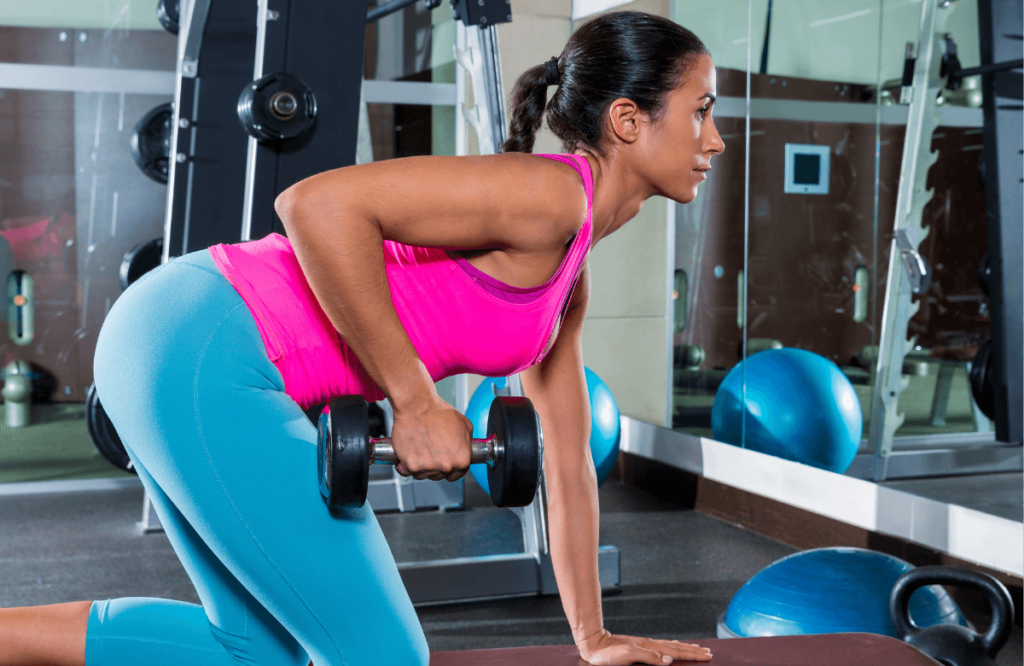
Common Mistakes and How to Avoid Them
Mistakes are inevitable, at least until you’ve got perfect form in your muscle memory. Focus on avoiding these common mistakes and you’ll gain more muscle mass, increase in strength, and have less chance of injury.
Using Momentum
Using momentum to swing the weight up defeats the point. You shouldn’t be whipping the weight towards you and relying on the speed and momentum to get it up. Nor should you be bending your knees and “bouncing” the weight up.
Your entire body should be still and stable as you contract your lats to bring the weight towards you. You should be relying entirely on the muscular contraction to lift the dumbbell. This is where gains are made!
Go slowly. If you can’t lift the weight without using momentum, then you’re lifting too heavy. Lower the weight and work on it until you can increase. You’ll thank yourself later!
Limiting Your Range of Motion
Doing half-reps gets you nowhere. You want to move the muscle through as full a range of motion as possible in order to get the most effective activation. This is what makes dumbbell lat exercises such an amazing alternative to barbells in the first place!
But if you’re using dumbbells and only lifting with a barbell range of motion, you’re selling yourself short. Make sure you’re moving your elbows as far back as they can go without breaking form, and feel the stretch across the entire muscle.
Not Controlling the Return to Start
If you’re just letting the dumbbell drop back to the original position, you’re missing out on muscle engagement. Control the dumbbell as you lower it back to the starting point—don’t just let the muscle disengage and drop the weight.
The lowering of the dumbbell is part of the full movement. This lowering action is called the eccentric phase of the movement. During lifting (concentric phase), the muscle contracts and shortens. During lowering, the muscle extends and lengthens.
During this phase, the muscle is engaged as much as it is when bringing it up. Neglecting this part of your lift not only means your risk of injury increases as the muscle suddenly disengages, but you’re also missing out on muscle growth.
Not Tightening Your Core
If you’re stabilizing yourself on a bench during dumbbell lat exercises, it’s a common mistake to forget to engage your core during the movement. While it’s not the end of the world, it does mean that you’re not as stable as you could be, and it’s far easier to lose your form as you do the movement.
Actively work on tightening your core every time you do these movements. If you need to, set up a sort of mental checklist (or physical checklist!) for your form, to make sure you’re doing everything right before lifting the weight.
Losing Your Grip
Lifting heavy weights is excellent for your muscles, but in some cases, your grip fails before you muscles do. It’s a common issue on exercises like rows, because gravity is working against you.
We advise using a wrist strap to give you some extra support. Don’ worry, it’s not cheating! You still have to lift the weight—the strap just helps the weight to stay in place without falling out of your grip.
If you don’t have a wrist strap, your only choice may be to lower the weight so you can do the movement with proper form. Ultimately, it’s worth spending a little on wrist straps so you can lift the kind of weight your muscles are capable of and need for growth!



